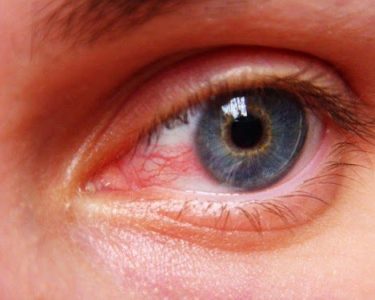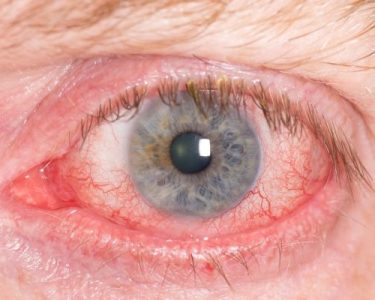Uveitis is inflammation of the middle layer of the eye – the uvea, also known as the uceal tract. The term Uveitis is frequently more loosely used for any inflammation of the interior of the eye. According to the CDC (Centers for Disease Control and Prevention), USA, approximately 10% of all cases of blindness in the United States are caused by uveitis.
The uvea, also known as uveal layer, uveal coat, uveal tract, or vascular tunic, consists collectively of the iris, the choroid of the eye, and the ciliary body. Inflammation of the iris (iritis) is the most common type of uveitis.
- The iris – the colored part of the eye that surrounds the pupil.
- The choroid of the eye – the part of the eye between the white of the eye (sclera) and the retina (the light sensing part at the back of the eye). The choroid of the eye is a thin vascular middle layer.
- The ciliary body – a ring of muscle behind the iris; this body of tissue connects the iris with the choroid.
Inflammation of the uvea may be painful. It usually causes a red eye, sometimes with cloudy vision.
An injury to the eye, a viral or bacterial infection, as well as some underlying diseases may cause uveitis. If left untreated the patient may suffer vision loss.
Types of Uveitis
- Anterior uveitis – frequently termed iritis. This type affects the front of the eye.
- Intermediate uveitis – consists of vitritis, inflammation of the jelly-like part of the eye (vitreous cavity). When there is inflammatory material on the pars plana, the condition is called pars planitis
- Posterior uveitis – inflammation of the retina and choroid. Posterior refers to the back of the eye.
- Pan-uveitis – is when inflammation exists in all layers of the uvea.
What are the symptoms of Uveitis?
Symptoms Of Uveitis is something the patient feels or reports, while a sign and Symptoms For Uveitis is something other people, including a doctor, may detect. For example, a pain may be a symptom while a rash may be a sign.
The signs, symptoms of uveitis may include:
- Blurred vision
- Cloudy vision
- Floaters – debris in the eye make you see tiny rods, chains of transparent bubbles floating around in your field of vision
- General vision problems
- Eye pain
- Eye redness
- Photophobia – abnormal sensitivity to light
- Headaches
- A small pupil
- Alteration of the color of the iris
Symptoms can come on gradually or rapidly.
What are the causes of Uveitis?
Causes Of Uveitis eye specialists do not usually know specifically why uveitis occurs, we do know about some situations and circumstances that make its likelihood greater. The following factors may increase the risk of developing Causes For Uveitis:
- Rheumatoid arthritis, psoriasis and other autoimmune disorders.
- A blow to the eye which may have caused an injury.
- AIDS/HIV and other diseases which weaken the immune system.
- Certain cancers, such as lymphoma, that have an indirect effect on the eye.
- Eye surgery.
- Inflammatory disorders, such as Crohn’s disease or ulcerative colitis.
- Some infections, including brucellosis, herpes simplex, herpes zoster, leptospirosis, lyme disease, syphilis, toxocariasis, toxoplasmosis, or tuberculosis. Uveitis may be a normal immune response to fight an infection inside the eye.
Diagnosis of Uveitis
A visit to the ophthalmologist will include questions about the signs, symptoms and general health history.
As underlying diseases may be involved in uveitis risk, the eye specialist (ophthalmologist) will refer the patient to a specialist to make sure that condition/illness is being properly treated. Determining whether the uveitis is caused by an infectious process or an underlying disease is important.
During the examination the ophthalmologist looks at the eye with a special slit lamp. In the case of uveitis, white blood cells and protein in the eye fluid can be seen through the microscope. When the light hits the inside of the eye, the doctor can determine whether that area is clear or foggy. Some patients may feel some pain if the inflammation is in the iris when the pupil contracts (when light hits it).
The doctor may also order blood tests and x-rays.
What is the treatment for Uveitis of disease?
Doctors say that the outlook (prognosis) for a patient with uveitis is usually good if they receive proper and prompt treatment. If not, there is a risk of cataracts, glaucoma, band keratopathy, retinal edema, and even permanent vision loss.
- Antibiotics or antivirals medication. If an infectious process is identified, the patient will be prescribed either an antibiotic (bacterial infection) or an antiviral (viral infection). Corticosteroids might be given in combination (not always).
- Corticosteroids. This steroid Treatment for Uveitis may be given as eye drops (prednisolone acetate), tablets or by intraocularly (injection into the eye). Steroids are effective in treating inflammation. Before giving corticosteroids, it is important rule out corneal ulcers by Florescence Dye test.
- Immunosuppressants. This type of medication might be recommended if symptoms are very severe and there is a risk of vision loss, or if the patient has not responded well to other therapies.
- Mydriatic eye drops, such as atropine or cyclopentolate. They dilate the pupil and help the eye to heal. This Treatment Of Uveitis also helps with eye pain. It will also stop the pupil from sticking to the lens. The patient may experience blurred vision and become overly sensitive to light (photophobia).
Natural Herbal Products for Uveitis Treatment
Uveitis Natural Treatment for Symptoms of eye Causes by Herbal Care Products. Uvical is best Uveitis Herbal Treatment. Natural Remedies for swelling, redness and pain cure.
What are the complications of Uveitis?
With prompt and proper treatment, as well as close monitoring, the chances of complications are significantly reduced. If complications do occur, they may include:
- Glaucoma
- Cataracts
- Macular edema
- Scar tissue
- Retinal detachment (detached retina)
- Vision loss
Source Link : https://www.medicalnewstoday.com/articles/166410.php




